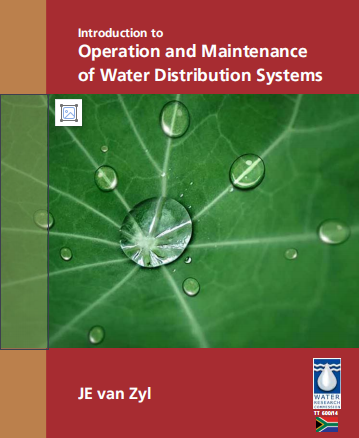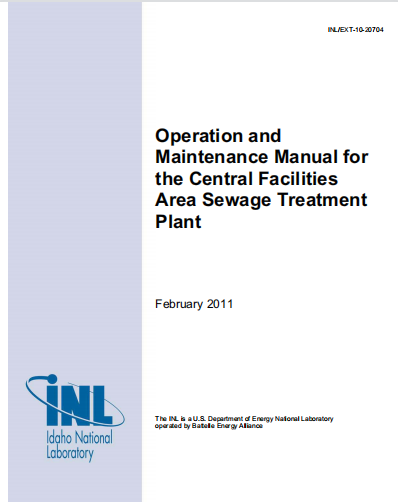Operation And Maintenance Manual For The Central Facilities Area Sewage Treatment Plant
Introduction
This Operation and Maintenance (O&M) Manual is the basic reference for the operation and maintenance of the equipment and processes that comprise the Central Facilities Area (CFA) Sewage Treatment Plant (STP) at the Idaho National Laboratory (INL) Site. The manual is required by the facility’s Municipal Wastewater Reuse Permit (LA-000141-03). Managers, operators, and maintenance personnel use this manual and associated company and equipment manufacturer’s procedures to operate the STP in support of CFA activities and permit requirements. The Laboratory Instructions (LI) listed below provide additional step-by-step instructions for operating specific components of the STP and laboratory equipment. LIs are prepared and cancelled as needed to provide directions for operating and maintaining STP equipment.
Operation And Maintenance Manual For The Central Facilities Area Sewage Treatment Plant
Introduction
This Operation and Maintenance (O&M) Manual is the basic reference for the operation and maintenance of the equipment and processes that comprise the Central Facilities Area (CFA) Sewage Treatment Plant (STP) at the Idaho National Laboratory (INL) Site. The manual is required by the facility’s Municipal Wastewater Reuse Permit (LA-000141-03). Managers, operators, and maintenance personnel use this manual and associated company and equipment manufacturer’s procedures to operate the STP in support of CFA activities and permit requirements. The Laboratory Instructions (LI) listed below provide additional step-by-step instructions for operating specific components of the STP and laboratory equipment. LIs are prepared and cancelled as needed to provide directions for operating and maintaining STP equipment.
Information Manual for Treatment Plant Operators
Introduction
Why was this manual created?
This manual was prepared to help wastewater treatment plant operators complete and submit their Discharge Monitoring Reports (DMRs) (sample DMR forms in Appendix B) and other annual reports to the Department of Ecology (Ecology). Many permittees also fill out a U.S. Environmental Protection Agency (EPA) DMR. This manual is also useful for completing the EPA form, if applicable. What if this manual is different from what I have been guided to do? This manual is intended to complement, but not supercede, the National Pollutant Discharge Elimination System (NPDES) or state waste discharge permit or applicable regulations, which are the legal documents to which the permittee will be held responsible. If ever there is a conflict between this guidance and either the NPDES/State Waste Discharge Permit or the applicable regulations, the permit or regulations will supercede this guidance.
Information Manual for Treatment Plant Operators
Introduction
Why was this manual created?
This manual was prepared to help wastewater treatment plant operators complete and submit their Discharge Monitoring Reports (DMRs) (sample DMR forms in Appendix B) and other annual reports to the Department of Ecology (Ecology). Many permittees also fill out a U.S. Environmental Protection Agency (EPA) DMR. This manual is also useful for completing the EPA form, if applicable. What if this manual is different from what I have been guided to do? This manual is intended to complement, but not supercede, the National Pollutant Discharge Elimination System (NPDES) or state waste discharge permit or applicable regulations, which are the legal documents to which the permittee will be held responsible. If ever there is a conflict between this guidance and either the NPDES/State Waste Discharge Permit or the applicable regulations, the permit or regulations will supercede this guidance.
Good Practice Guide to the Operation of Drinking Water Supply Systems for the Management of Microbial Risk
INTRODUCTION
Purpose of Good Practice Guide The catchment-to-consumer risk-based approach to the production of microbially-safe drinking water, which is detailed in the Framework for Management of Drinking Water Quality (the Framework) that underpins the Australian Drinking Water Guidelines (ADWG), is based on the identification and control of risks to the quality of drinking water supplied to consumers. This reduction in risk is achieved by implementing a multiple barrier approach, where a number of different barriers to contamination are put in place, from the catchment to the consumer. Whilst the risk management
process stretches all the way from catchment to consumer, in practice the majority of risks are managed through the use of various water treatment processes. Most Australian source waters require some level of treatment prior to being supplied to consumersas drinking water. The level of treatment required to produce microbially-safe drinking water will be a function of the quality of the source water and should be informed by a system-specific risk
assessment process that is consistent with the approach described under Element 2 (Assessment of the drinking water supply system) of the Framework.
The production of microbially-safe drinking water is difficult to consistently achieve, and requires constant vigilance, as well as well-maintained and operated water treatment processes (Element 3 (Preventive measures for drinking water quality management) and Element 4 (Operational procedures
and process control) of the Framework). Within this risk-based approach, the purpose of this Guide is to provide concise advice on good practice preventive measures for the management of drinking water treatment processes and the distribution of this treated water to consumers. This is achieved by providing targets, both numerical and observational, for the various activities that should be undertaken in order to produce microbiallysafe drinking water.
The Guide is not intended to be a risk assessment tool; it assumes that a system-specific risk assessment has been done, and that the treatment and distribution processes that are present are suitable for the assessed level of microbial risk. The Guide is therefore focused on the optimisation,
management and control of existing water supply systems. The advice in this Guide is applicable to existing water supply systems and is intended to help water utilities produce microbially-safe drinking water under existing arrangements; it will also assist utilities meet any future microbial health-based targets that may be includes in the ADWG. The Guide is presented in a tabular format for simplicity. The table is broken into sections that relate
to the key control points in typical water treatment and distribution systems.
Good Practice Guide to the Operation of Drinking Water Supply Systems for the Management of Microbial Risk
INTRODUCTION
Purpose of Good Practice Guide The catchment-to-consumer risk-based approach to the production of microbially-safe drinking water, which is detailed in the Framework for Management of Drinking Water Quality (the Framework) that underpins the Australian Drinking Water Guidelines (ADWG), is based on the identification and control of risks to the quality of drinking water supplied to consumers. This reduction in risk is achieved by implementing a multiple barrier approach, where a number of different barriers to contamination are put in place, from the catchment to the consumer. Whilst the risk management
process stretches all the way from catchment to consumer, in practice the majority of risks are managed through the use of various water treatment processes. Most Australian source waters require some level of treatment prior to being supplied to consumersas drinking water. The level of treatment required to produce microbially-safe drinking water will be a function of the quality of the source water and should be informed by a system-specific risk
assessment process that is consistent with the approach described under Element 2 (Assessment of the drinking water supply system) of the Framework.
The production of microbially-safe drinking water is difficult to consistently achieve, and requires constant vigilance, as well as well-maintained and operated water treatment processes (Element 3 (Preventive measures for drinking water quality management) and Element 4 (Operational procedures
and process control) of the Framework). Within this risk-based approach, the purpose of this Guide is to provide concise advice on good practice preventive measures for the management of drinking water treatment processes and the distribution of this treated water to consumers. This is achieved by providing targets, both numerical and observational, for the various activities that should be undertaken in order to produce microbiallysafe drinking water.
The Guide is not intended to be a risk assessment tool; it assumes that a system-specific risk assessment has been done, and that the treatment and distribution processes that are present are suitable for the assessed level of microbial risk. The Guide is therefore focused on the optimisation,
management and control of existing water supply systems. The advice in this Guide is applicable to existing water supply systems and is intended to help water utilities produce microbially-safe drinking water under existing arrangements; it will also assist utilities meet any future microbial health-based targets that may be includes in the ADWG. The Guide is presented in a tabular format for simplicity. The table is broken into sections that relate
to the key control points in typical water treatment and distribution systems.
Drinking Water Operator Certification Training Module #24 Gas Chlorination
Learning Objectives
. Explain the purpose of chlorination.
. Describe the two forms of chlorine.
. Describe the properties of liquid chlorine and gaseous chlorine.
. Explain how chlorine reacts in aqueous solutions.
. Read and explain chlorine reaction equations.
Drinking Water Operator Certification Training Module #24 Gas Chlorination
Learning Objectives
. Explain the purpose of chlorination.
. Describe the two forms of chlorine.
. Describe the properties of liquid chlorine and gaseous chlorine.
. Explain how chlorine reacts in aqueous solutions.
. Read and explain chlorine reaction equations.
Drinking Water Operator Certification Training WDC Volume II
Learning Objectives
. Define maintenance
. Discuss the roles of maintenance
. Discuss safety practices of maintenance
Drinking Water Operator Certification Training WDC Volume II
Learning Objectives
. Define maintenance
. Discuss the roles of maintenance
. Discuss safety practices of maintenance










